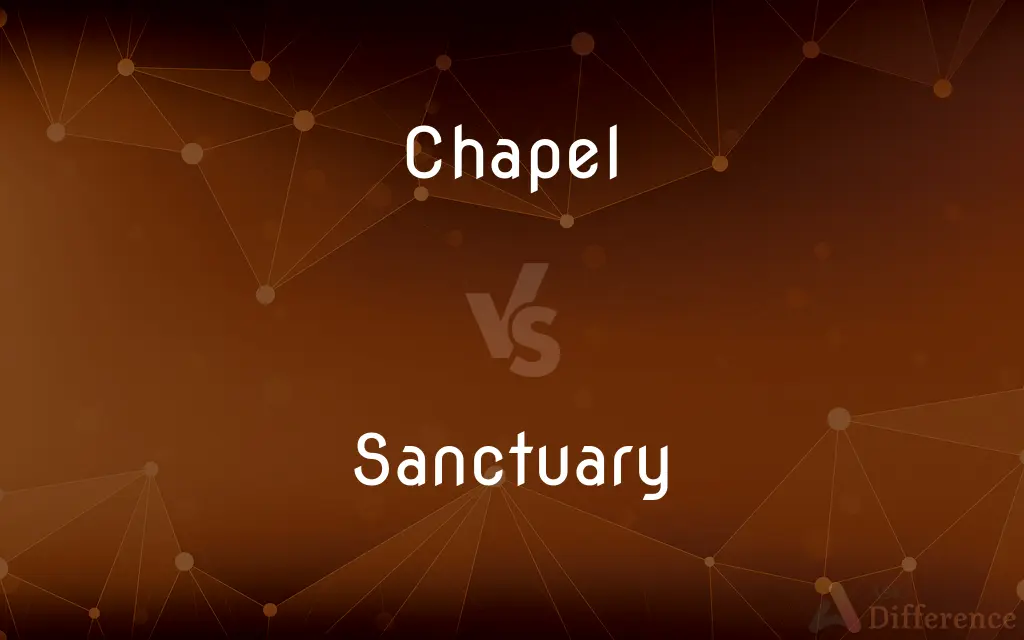Chapel vs. Sanctuary — What's the Difference?
By Urooj Arif & Maham Liaqat — Updated on March 5, 2024
A chapel is a small place of worship, often within a larger institution. A sanctuary is a sacred or holy place, often the main area of worship within a church.

Difference Between Chapel and Sanctuary
Table of Contents
ADVERTISEMENT
Key Differences
Chapels are typically smaller, more intimate spaces for worship and can be found within larger institutions like schools, hospitals, or even within a church. Sanctuaries, on the other hand, are often the principal or holiest area within a religious building, especially in churches, where congregational services are held.
While chapels serve as spaces for private prayer, smaller services, or special ceremonies like weddings, sanctuaries are designed to accommodate larger congregations for regular worship and significant religious ceremonies. Sanctuaries are usually the central space of worship and may contain important religious symbols and artifacts.
Chapels offer flexibility in use and can be non-denominational, providing a place of worship for people of various faiths within public institutions. Sanctuaries are typically specific to the denomination of the church they are part of, reflecting the theological and liturgical practices of that faith community.
The architectural design of chapels is often simpler and more varied, reflecting the needs and preferences of the institution or property they are part of. Sanctuaries, however, are usually more grandiose and structured, with designs that emphasize their importance as a place of worship and community gathering.
Despite these differences, both chapels and sanctuaries play vital roles in spiritual life and community. They provide spaces for reflection, prayer, and community engagement, each serving its purpose within the broader religious and cultural landscape.
ADVERTISEMENT
Comparison Chart
Size and Location
Smaller, can be located within larger buildings
Main area within a religious building, usually larger
Purpose
Private prayer, small ceremonies
Congregational worship, significant religious ceremonies
Denomination
Can be non-denominational
Usually denomination-specific
Architectural Design
Simpler, varied
Grandiose, structured
Usage
Flexible for various faiths and services
Focused on community worship and major ceremonies
Compare with Definitions
Chapel
A small building or room used for Christian worship, typically one attached to an institution or private house.
The hospital chapel offered solace to many families.
Sanctuary
The main area of worship in a church, where the congregation gathers.
The community gathered in the sanctuary for the holiday celebration.
Chapel
A room or building for prayer or religious ceremonies, not necessarily Christian.
The naval academy had a chapel for cadets of all faiths.
Sanctuary
A sacred or holy place where worship and religious ceremonies are performed.
The ancient sanctuary was a site of pilgrimage for many.
Chapel
A place of worship for people when they are away from their main church.
Soldiers visited the chapel for services while stationed abroad.
Sanctuary
A place offering protection, often with religious connotations.
The wildlife sanctuary provided a safe haven for endangered species.
Chapel
A service conducted in a chapel;
He was late for chapel
Sanctuary
A place of refuge or safety, often used in a religious context.
The church offered sanctuary to those in need.
Chapel
A building used by Christian communities for religious activities other than the main church.
The college chapel was a center for spiritual life on campus.
Sanctuary
The holiest part of a religious building, especially in a Christian church, reserved for the clergy.
The sanctuary was prepared for the Sunday service.
Chapel
A chapel is a Christian place of prayer and worship that is usually relatively small. The term has several senses.
Sanctuary
A sanctuary, in its original meaning, is a sacred place, such as a shrine. By the use of such places as a haven, by extension the term has come to be used for any place of safety.
Chapel
A place of worship that is smaller than and subordinate to a church.
Sanctuary
A sacred place, such as a church, temple, or mosque.
Chapel
A place of worship in an institution, such as a prison, college, or hospital.
Sanctuary
The holiest part of a sacred place, as the part of a Christian church around the altar.
Chapel
A place of worship, smaller than or subordinate to a church.
Sanctuary
A sacred place; a consecrated spot; a holy and inviolable site.
These laws, whoever made them, bestowed on temples the privilege of sanctuary.
The admirable works of painting were made fuel for the fire; but some relics of it took sanctuary under ground, and escaped the common destiny.
Chapel
A place of worship not connected with a church; as, the chapel of a palace, hospital, or prison.
Sanctuary
A consecrated place where sacred objects are kept
Common Curiosities
Can chapels be found outside of churches?
Yes, chapels can be located in various institutions like schools, hospitals, or even private homes.
Can anyone use a chapel for worship?
Generally, chapels are more flexible in their use and can accommodate people of various faiths, especially in non-denominational settings.
What defines a chapel compared to a sanctuary?
A chapel is a smaller place of worship, possibly non-denominational and located within a larger institution, while a sanctuary is the main, holy area of worship within a church.
Are sanctuaries considered more sacred than chapels?
Sanctuaries are usually seen as the holiest parts of religious buildings, especially in churches, but chapels also hold significant spiritual importance for many.
Can the terms chapel and sanctuary be used interchangeably?
While they both refer to places of worship, their usage is not interchangeable due to differences in size, purpose, and denominational specificity.
Do chapels serve a different purpose than sanctuaries?
Chapels provide a space for more intimate, personal worship or special ceremonies, whereas sanctuaries are designed for larger congregations and significant religious ceremonies.
How does the denomination affect the use of chapels and sanctuaries?
Sanctuaries reflect the liturgical practices of their denomination, while chapels, especially non-denominational ones, can serve a broader range of faith practices.
Can sanctuaries offer protection or asylum?
Historically and in some contemporary contexts, sanctuaries in churches have offered refuge and safety to individuals seeking asylum.
Are there modern interpretations of chapels and sanctuaries?
In contemporary architecture, both chapels and sanctuaries adapt to modern aesthetic and functional needs while maintaining their spiritual significance.
Is a sanctuary always part of a church?
Typically, yes, the sanctuary is a significant part of a church, serving as the main area for congregational worship.
What architectural differences exist between chapels and sanctuaries?
Chapels tend to have simpler, more varied designs, while sanctuaries often feature grandiose architecture emphasizing their importance for worship.
How do chapels accommodate multiple faiths?
Chapels, especially in institutions like hospitals or universities, often provide various religious symbols and texts to accommodate different faiths.
What makes a sanctuary sacred?
Sanctuaries are deemed sacred due to their role in hosting significant religious ceremonies and housing important religious symbols and artifacts.
Can the design of a chapel influence its use?
Yes, the design of a chapel can affect its ambiance, capacity for ceremonies, and ability to accommodate diverse religious practices.
What role do chapels and sanctuaries play in a community?
Both serve as vital spaces for spiritual reflection, prayer, and community engagement, supporting the religious and communal needs of individuals.
Share Your Discovery

Previous Comparison
Underground vs. Metro
Next Comparison
Moco vs. MomoAuthor Spotlight
Written by
Urooj ArifUrooj is a skilled content writer at Ask Difference, known for her exceptional ability to simplify complex topics into engaging and informative content. With a passion for research and a flair for clear, concise writing, she consistently delivers articles that resonate with our diverse audience.
Co-written by
Maham Liaqat













































